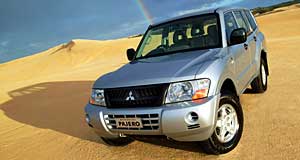First drive: Pajero's power present
BY BRUCE NEWTON | 15th Sep 2003

That extra kick comes courtesy of a bored and stroked version of the Pajero’s 3497cc single overhead camshaft engine, which is now out to 3828cc.
There are some other changes and adjustments – most notably the pricing of some Di-D turbo-diesel models that drop significantly – but the bigger engine is the key improvement.
It should be noted up-front that only automatic Pajeros get the 3.8, with the manual staying with the 3.5. But Mitsubishi’s figures show 86 per cent of buyers tick the auto option anyway, so the vast majority are still set to gain from the move.
The extra capacity, along with some other fiddles like a variable intake manifold and lighter moving parts including valves, pistons, connecting rods and crankshaft, mean power has gown from 140kW to 150kW at the same 5000rpm.
Torque has climbed from 303Nm to 314Nm, the peak delivered 250rpm lower in the rev range at 3250rpm thanks to that new inlet manifold, which Mitsubishi also claims improves low and mid-range torque spread.
Mitsubishi also says the 3.8, which was launched on Pajero in the US last year, provides noticeable acceleration improvements over the 3.5, although it only furnishes claimed percentage improvements rather than raw figures. It says fuel consumption is barely changed compared to the old engine.
The 3.8 is also LPG compatible and achieves Euro II emissions ratings.
Mated to the engine is a new electronic throttle, which enables eight-sensor stability control to be standard on all 3.8s, whereas previously a four-sensor system was only available with the new generation diesel introduced last year.
But there’s more to the electronic safety story, with ABS (including EBD) now standard across the range, while 3.5s pick up active traction control across all models, where previously it was only standard on the top-spec Exceed.
All this electro-trickery has been christened MATT, or Mitsubishi All Terrain Technology, a move which smacks of apeing the Pajero’s recently updated competitor, the Toyota Prado, which calls its various systems DAT, or Driver Assist Technology.
Since the Prado went on sale in February, it has simply sky-rocketed in sales, outpacing the Pajero which had comfortably kept pace with the old Toyota wagon.
Pajero sales have averaged 655 a month so far this year and Mitsubishi wants to push that to 900 with the advent of the 2004 model, albeit still labelled as NP, a code introduced last year. By comparison, the Prado is currently averaging 1154 sales a month.
Apart from those engine and safety changes already mentioned, there are minor cosmetic changes and updates, the most significant probably being the upgrade of the base model GLX to the same 16 x 7-inch alloy wheels as the mid-spec GLS. The latter model also picks up a six-CD stacker.
Prices have increased marginally on GLX models and Exceed, but have remained the same on GLS and reduced on GLX and GLS diesel models, by $1700 on the former and $2420 on the latter.
PRICING:
Mitsubishi Pajero GLX 3.5-litre $46,390
Mitsubishi Pajero GLX 3.8-litre auto $49,390
Mitsubishi Pajero GLX 3.2-litre Di-D $48,590
Mitsubishi Pajero GLX 3.2-litre Di-D auto $51,590
Mitsubishi Pajero GLS 3.5-litre $52,590
Mitsubishi Pajero GLX 3.8-litre auto $55,590
Mitsubishi Pajero GLX 3.2-litre Di-D $53,990
Mitsubishi Pajero GLX 3.2-litre Di-D auto $56,990
Mitsubishi Pajero Exceed 3.8-litre V6 auto $62,990
Mitsubishi Pajero Exceed 3.2-litre Di-D auto $66,990
DRIVE IMPRESSIONS:
YOU’VE already gathered the changes to Pajero for 2004 are not that significant, which is not bad news really.The revamped engine gives that little more oomph, shows evidence of being that little more flexible and no sign of increased harshness or noise. A win-win judging by the first drive, although we await a full test to examine fuel consumption figures.
Of course, the engine mates to that lovely INVECS II five-speed auto with sequential shift, which means you are rarely without the right gear at the right time. Being a full bottle off-roader, there is an effective low range as well.
The handling behaviour and ride of the Pajero continues to be among the best in class, at least in part because of its car-like monocoque chassis construction, where most rivals including the Prado still favour the traditional ladder frame.
That means on-road behaviour is good, yet its substantial ground clearance and wheel articulation still give it considerable off-road abilities.
Now all that does not mean it echoes a sports car in its behaviour. This is a large vehicle, well capable of seating seven adults and weighing in at a minimum of 2070kg. It is quite ponderous, requires plenty of steering effort and likes progressive and smooth driving.
Where we noticed the new stability control system most was on gravel roads rather than rock hopping. With its weight and high centre of gravity - and even when the "Super Select" all-wheel drive system is engaged - it will still surrender to physics and slide around and lose grip if provoked.
This is where ASC is a boon, feathering the throttle and braking the appropriate wheels to bring things back under control. It certainly works, although at times we also found it surprisingly intrusive in situations that did not warrant its involvement.
Overall this is a relatively mild upgrade of Pajero, in line with a lot of model fettling and adjustment Mitsubishi has performed in 2003, most notably to the looks of the Magna and Lancer.
In this case the looks stay unchanged, but the already impressive mechanical package has received a worthy improvement.
Happy Birthday Pajero!